| Article ID | Journal | Published Year | Pages | File Type |
|---|---|---|---|---|
| 661436 | International Journal of Heat and Mass Transfer | 2009 | 6 Pages |
Recently, a novel method of measuring the thermophysical properties, particularly thermal conductivity, of high-temperature molten materials using the electromagnetic levitation technique has been developed by Kobatake et al. [H. Kobatake, H. Fukuyama, I. Minato, T. Tsukada, S. Awaji, Noncontact measurement of thermal conductivity of liquid silicon in a static magnetic field, Appl. Phys. Lett. 90 (2007) 094102]; this method is based on a periodic laser-heating method, and entails the superimposing of a static magnetic field to suppress convection in an electromagnetically levitated droplet. In this work, to confirm the fact that a static magnetic field really suppresses convection in a molten silicon droplet in an electromagnetic levitator, numerical simulations of convection in the droplet and periodic laser heating in the presence of convection have been carried out. Here, the convections driven by buoyancy force, thermocapillary force due to the temperature dependence of the surface tension on the melt surface, and electromagnetic force in the droplet were considered. As a result, it was found that applying a static magnetic field of 4 T can suppress convection in a molten silicon droplet enough to measure the real thermal conductivity of molten silicon.
